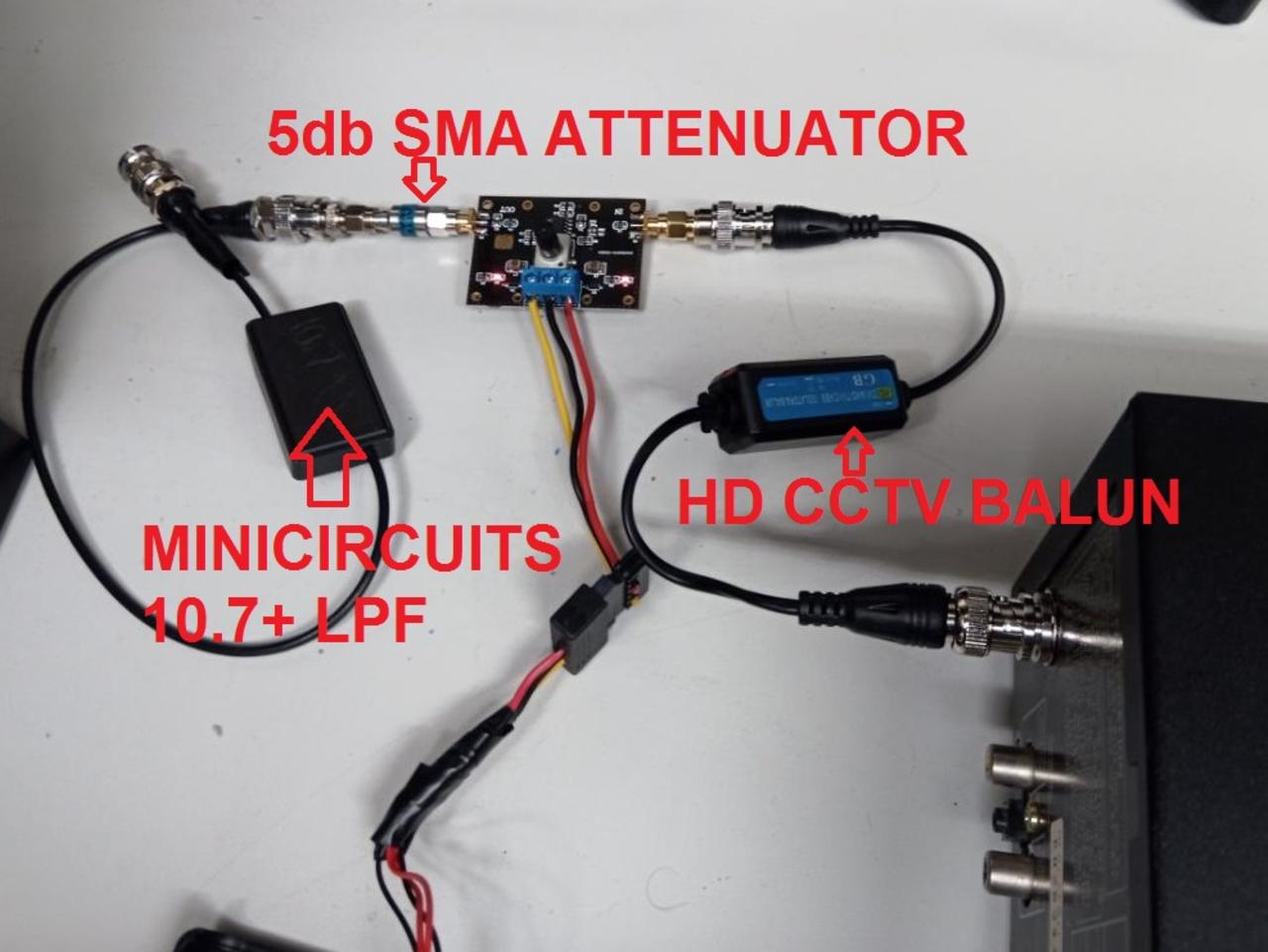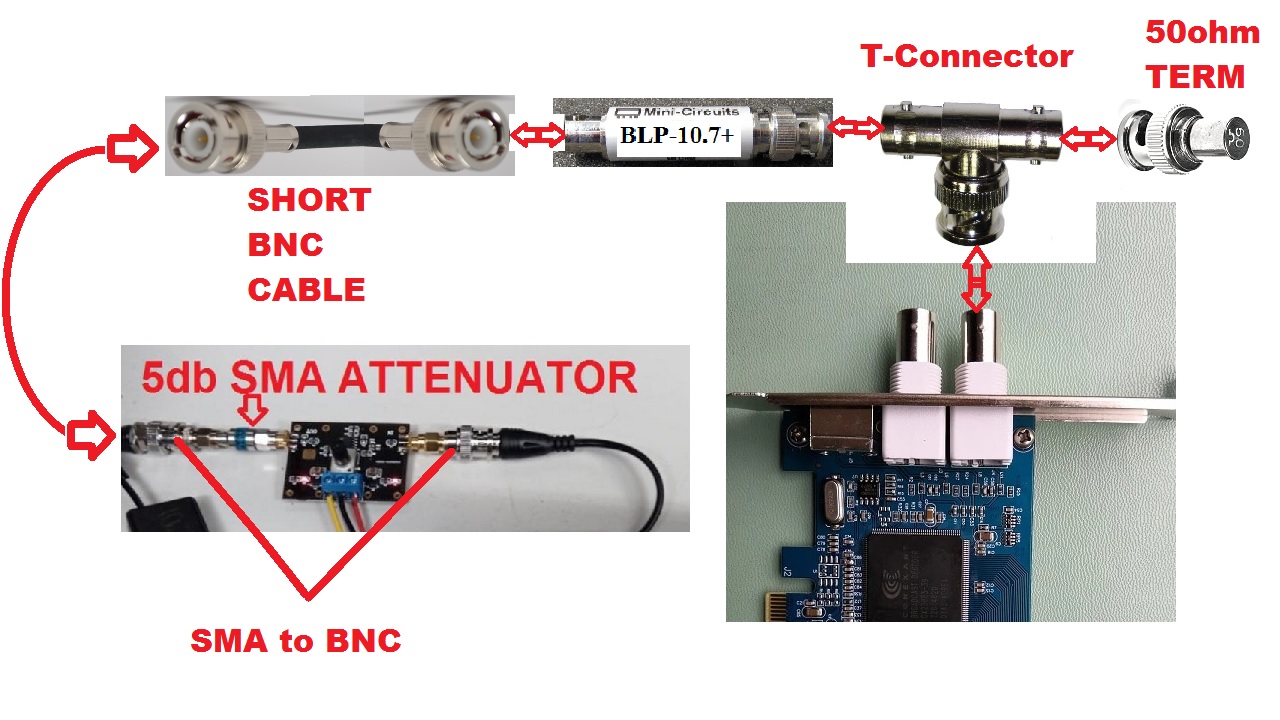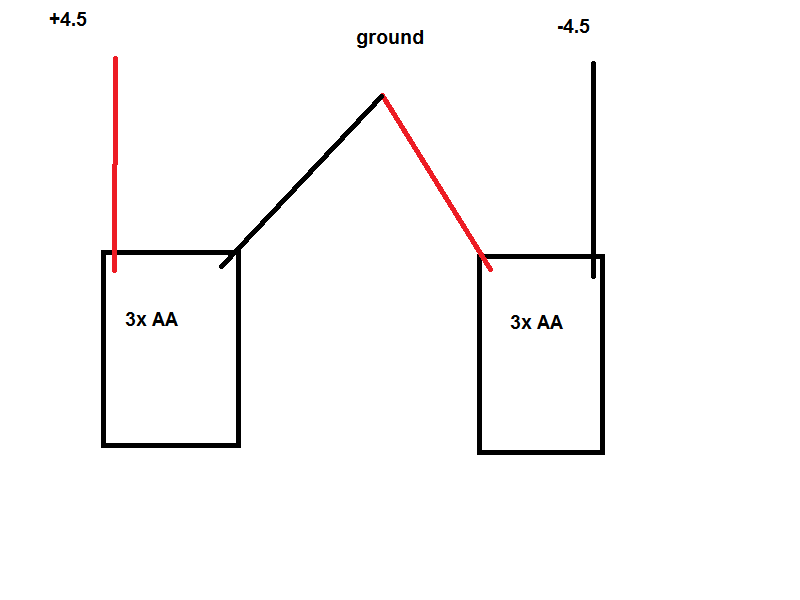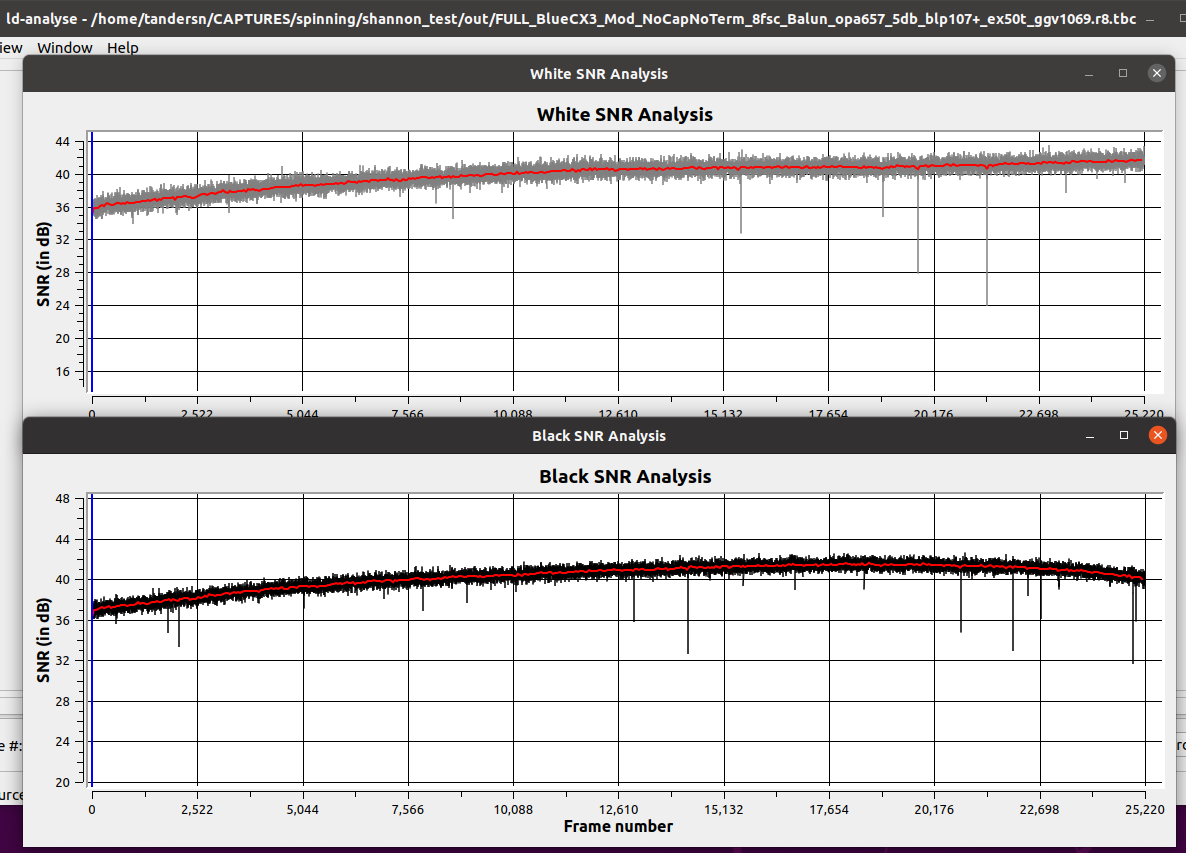|
It is currently 26 Apr 2024, 17:45
|
View unsolved topics | View unanswered posts
 |
|
 |
|
| Author |
Message |
|
9954tony
|
Post subject: Re: (WIP) Laserdisc software image decoder from raw signal  Posted: 24 Nov 2020, 20:10 |
| Serious fan |
 |
 |
Joined: 12 Sep 2015, 05:57
Posts: 210
Location: United States
Has thanked: 5 times
Been thanked: 54 times
|
I am still "fine tuning" my setup, but things are steadily improving. Currently, the setup is (all coax is rg174): 1. 4300D (uncalibrated, but supposedly "new in box" when i bought it, and appeared as such) 2. tapping RF off of pickup rather than internal RF test point (avoids 90s era amplification circuitry) 3. inline 50ohm (51 actually) resistor 4. pre made OPA657 amplifier board with manual gain adjustment: LINK mounted in a project box, SMA connectors removed, coax attached to board, and to BNC connectors. Powered with 6 "AA" batteries in 2 3x holders: LINK5. an inline 20ohm resistor (should probably be higher ohm, the amp amplifies a lot, and is easy to overload the ADC) 6. 13+mhz low pass filter from mini circuits: link coax connected to BNC connectors so it is removable. 7. BNC "T" connector and 50ohm termination ( i like to have the option to remove it, but could be integrated into modified card) 7. Capture card, PCIe CXADC card: LINK which is modified, removing onboard LPF, onboard 75ohm termination, BNC port added where one of the RCA jacks was, wire connecting to the DC blocking cap on the circuit board for the S-Video input. 28.636mhz crystal replaced with 40mhz: LINK for 40msps capture without driver modification. Things i am still investigating: 1. using alternate (10.7+) LPF 2. improved connection to PCIe board (get closer to chip pin to reduce exposed trace, which can pick up interference) 3. my short captures are better than long ones at same settings, indicating maybe a heat sink is needed? 4. update the driver to do 40msps without changing crystal (progress made, but S/N is poor). For those that "only have a laptop" would be interesting to know if something like this works: mini pcie to pcieChapter 33 of ggv1069: 
Last edited by 9954tony on 28 Aug 2021, 19:39, edited 1 time in total.
|
|

|
|
 |
|
titan91
|
Post subject: Re: (WIP) Laserdisc software image decoder from raw signal  Posted: 10 Dec 2020, 02:44 |
| Honest fan |
 |
 |
Joined: 14 Jul 2019, 02:53
Posts: 81
Location: United States
Has thanked: 10 times
Been thanked: 4 times
|
The results with the properly modified card are marginally better. The noise floor at gain level 15 is excellent:  They were much better for 9954tony on this same card, but he is using a proper amplifier and a player with a higher RF output. I have the same amplifier he is using on order. This one claims up to 89dB of gain, based on the OPA657 IC used in the Domesday Duplicator: https://www.ebay.com/itm/OPA657-High-Sp ... r=1&_rdt=1Currently, here's a result of the beginning of my CAV side:  Getting better. Still low frequency luma noise in the image though in the form of wide bands. The chroma adjustments in ld-analyse have no effect on this. Next I tried further into the CAV side near frame 9,000 (5 minutes) which is where the "flip the disc" message ends. This gives me 3dB of additional gain, putting me at SNR of 30dB.   Next, I opened up my player and adjusted a voltage regulator pot labeled "RF level" until my amplifier comes in. When I found out this is safe, I turned it up all the way. It was at about 50% from the factory and I can change this back later. This probably got me a whole decibel of additional SNR, barely measurable. The waveform is definitely higher, but SNR barely changes due to the weak signal.  CLV content side with gain pot at 50%:  CAV message side with the gain pot at 100%:  I'll post an update when the amplifier comes in. Out of all the ones 9954tony has tested over the last few months, this is the best performing one. It appears to be designed for photodiodes and the characteristics of the type of RF signal generated by them. CD players, LaserDisc players, etc. |
|

|
|
 |
|
titan91
|
Post subject: Re: (WIP) Laserdisc software image decoder from raw signal  Posted: 06 Jan 2021, 02:06 |
| Honest fan |
 |
 |
Joined: 14 Jul 2019, 02:53
Posts: 81
Location: United States
Has thanked: 10 times
Been thanked: 4 times
|
The results with the OPA657 amplifier aren't good. The image is similar to what I was getting on my ATI cards, just garbage. I found a strong pulsing signal in the upper band, whose pattern resembles fields of video when comparing waveforms in Audacity. I was thinking maybe a ground loop or the ground I had tapped wasn't true ground. So I moved the ground to the official ground pin on the test point, with the same result. This noise is present with and without the LPF. Without and with the filter respectively:   Being my captured bandwith is 20MHz wide, the signal appears to be exactly at 75% on the band, or 15MHz. I immediately thought maybe this was from the RF modulator, and the video pulses were QAM modulated onto the carrier. Channel 3 is 61.25MHz, and its 4th lower harmonic is 15.3125MHz. This would make perfect sense, if this machine even had an RF output! It does not. I found a "VHF adapter" port, which is just audio, video, and a 12vDC power jack for an external modulator, which I don't have. So I moved the player to the same power outlet as my capture PC, and even connected the composite output to input jacks on another device to rule that out. I don't have anything else turned on in the same room, especially near the OPA657. I'm also powering the amplifier with 100% clean DC +4.5v and -4.5V supplies from AA battery packs. But the noise is still there, and I have no explanation other than the CLD-V720's test point is simply poorly designed. Or, there's another issue with my particular player. Bad capacitors or something allowing noise from other circuits back through. In the midst of this, I'll probably still use the modified card for vhs-decode with my VCR instead. The ultimate conclusion though is, just any LaserDisc player with an RF test point will NOT work. |
|

|
|
 |
|
titan91
|
Post subject: Re: (WIP) Laserdisc software image decoder from raw signal  Posted: 17 Jan 2021, 00:18 |
| Honest fan |
 |
 |
Joined: 14 Jul 2019, 02:53
Posts: 81
Location: United States
Has thanked: 10 times
Been thanked: 4 times
|
My hard drive died. After installing Linux Mint 20.1 (Ubuntu 20.04 base) with a new drive I can no longer build cxadc. I didn't have this issue before. Here's what I get following the GitHub instructions: user@mintiplex:~/Downloads/cxadc-linux3-master$ make && sudo make modules_install
make -C /lib/modules/`uname -r`/build M=$PWD
make[1]: Entering directory '/usr/src/linux-headers-5.4.0-62-generic'
Building modules, stage 2.
MODPOST 1 modules
make[1]: Leaving directory '/usr/src/linux-headers-5.4.0-62-generic'
make -C /lib/modules/`uname -r`/build M=$PWD modules_install
make[1]: Entering directory '/usr/src/linux-headers-5.4.0-62-generic'
INSTALL /home/user/Downloads/cxadc-linux3-master/cxadc.ko
At main.c:160:
- SSL error:02001002:system library:fopen:No such file or directory: ../crypto/bio/bss_file.c:69
- SSL error:2006D080:BIO routines:BIO_new_file:no such file: ../crypto/bio/bss_file.c:76
sign-file: certs/signing_key.pem: No such file or directory
DEPMOD 5.4.0-62-generic
Warning: modules_install: missing 'System.map' file. Skipping depmod.
make[1]: Leaving directory '/usr/src/linux-headers-5.4.0-62-generic'
user@mintiplex:~/Downloads/cxadc-linux3-master$ sudo insmod cxadc.ko vmux=2 level=1
insmod: ERROR: could not insert module cxadc.ko: Invalid module format
dmesg log shows: [ 85.295496] cxadc: version magic '5.4.0-58-generic SMP mod_unload ' should be '5.4.0-62-generic SMP mod_unload '
[ 91.645527] cxadc: version magic '5.4.0-58-generic SMP mod_unload ' should be '5.4.0-62-generic SMP mod_unload '
I did try a reboot, same issue. I built the module again and tried to insert and got the same error again. For some reason make wasn't building against the active kernel, it was building against another version of the kernel that was installed. I figured it out, what happened was I built the module then installed a kernel update. Following the reboot, it wouldn't insert because of the kernel version mismatch. Running make again should have worked, and it used to for me in the past when I installed kernel updates. But it did not this time. The root cause was make was re-using one or more files in the cxadc source folder. I had to delete the folder and re-extract it clean from the GitHub zip file. Ran the same command again and cxadc built, inserted, and is working now no problem. |
|

|
|
 |
|
titan91
|
Post subject: Re: (WIP) Laserdisc software image decoder from raw signal  Posted: 30 Jan 2021, 21:05 |
| Honest fan |
 |
 |
Joined: 14 Jul 2019, 02:53
Posts: 81
Location: United States
Has thanked: 10 times
Been thanked: 4 times
|
I and others have seen constant issues where cxadc doesn't want to work when loading the kernel module. The errors in the terminal state the device doesn't exist, yet the /dev/cxadc0 special device file is there. I think I found out why this is constantly happening with Ubuntu and Mint. It seems to be driver signature enforcement in the kernel. When building, I get this: make && sudo make modules_install
make -C /lib/modules/`uname -r`/build M=$PWD
make[1]: Entering directory '/usr/src/linux-headers-5.4.0-62-generic'
AR /home/user/Downloads/cxadc-linux3-master/built-in.a
CC [M] /home/user/Downloads/cxadc-linux3-master/cxadc.o
Building modules, stage 2.
MODPOST 1 modules
CC [M] /home/user/Downloads/cxadc-linux3-master/cxadc.mod.o
LD [M] /home/user/Downloads/cxadc-linux3-master/cxadc.ko
make[1]: Leaving directory '/usr/src/linux-headers-5.4.0-62-generic'
[sudo] password for user:
make -C /lib/modules/`uname -r`/build M=$PWD modules_install
make[1]: Entering directory '/usr/src/linux-headers-5.4.0-62-generic'
INSTALL /home/user/Downloads/cxadc-linux3-master/cxadc.ko
At main.c:160:
- SSL error:02001002:system library:fopen:No such file or directory: ../crypto/bio/bss_file.c:69
- SSL error:2006D080:BIO routines:BIO_new_file:no such file: ../crypto/bio/bss_file.c:76
sign-file: certs/signing_key.pem: No such file or directory
DEPMOD 5.4.0-62-generic
Warning: modules_install: missing 'System.map' file. Skipping depmod.
make[1]: Leaving directory '/usr/src/linux-headers-5.4.0-62-generic'
And when checking the dmesg logs, I get this: 13:48:10 kernel: cxadc driver loaded
13:48:10 kernel: cxadc: module verification failed: signature and/or required key missing - tainting kernel
13:48:10 kernel: cxadc: module verification failed: signature and/or required key missing - tainting kernel
13:48:10 kernel: cxadc: loading out-of-tree module taints kernel.
13:48:10 sudo: user : TTY=pts/0 ; PWD=/home/user/Downloads/cxadc-linux3-master ; USER=root ; COMMAND=/usr/sbin/insmod cxadc.ko vmux=2 level=1
What's weird is I never had this issue for months at a time, then started having the problem. Maybe there was an update that changed the driver signature enforcement or something. It's not the first problem where the module wouldn't insert due to kernel version being incompatible. I get no errors in the terminal when inserting it but when I run rmmod, I get a message saying the module isn't even loaded. The device file creates fine, but the module doesn't load for that reason. I removed that folder and re-extracted/re-built the module. Tried inserting again, it says the file exists. Yet, I can't access cxadc0 and using rmmod says it's still not loaded. I read somewhere there are two solutions, one is signing the kernel module so the kernel will load it. Another is re-building the kernel with an enforcement flag disabled (lol). I still don't understand why so many people seem to not have this issue, but one of the Discord guys and I do. I also read secure boot in the UEFI settings could cause this, and the CMOS battery did die and clear my settings about a month ago. However, I checked today and secure boot is turned off. |
|

|
|
 |
|
titan91
|
Post subject: Re: (WIP) Laserdisc software image decoder from raw signal  Posted: 27 Mar 2021, 22:13 |
| Honest fan |
 |
 |
Joined: 14 Jul 2019, 02:53
Posts: 81
Location: United States
Has thanked: 10 times
Been thanked: 4 times
|
I took a hiatus from this to work on my vhs-decode workflow, which allowed me to get a very nice 46dB SNR from those captures. In that case, my OPA657 amplifier screwed up the captures. To get an SNR number that high I tapped the VCR using a BNC connector and mini coax going directly to my CX card with another 1ft mini coax to s-video pigtail adapter cable and 13MHz filter, with the external amp out of the picture entirely. With that in mind, 9954tony has helped me find a Pioneer CLD-S250 machine that seems to work better for captures. I tried the amplifier on it and got nothing on the output at all. I connected the player directly to the same CX card using the 13MHz filter with a long 6ft mini coax cable (strike 1), with factory 5MHz low pass filtering on the card (strike 2), and a 75 ohm based impedance on the unmodified card (strike 3). Still, with all that, I'm probably getting the cleanest capture from LaserDisc as of yet. It's really weak and only 20dB black SNR so far, but the decode isn't bad for starters and the FM audio is flawless. Next I'm going to swap my card to a modified one to bypass the stock low pass filter caps and 75 ohm terminating resistors and test again, with a 50 ohm terminator added which I have not tried before.    |
|

|
|
 |
|
titan91
|
Post subject: Re: (WIP) Laserdisc software image decoder from raw signal  Posted: 12 May 2021, 01:32 |
| Honest fan |
 |
 |
Joined: 14 Jul 2019, 02:53
Posts: 81
Location: United States
Has thanked: 10 times
Been thanked: 4 times
|
I picked up a 1979 DiscoVision title, "Heroes." For DiscoVision, it's not bad video wise. However, there is some weird drop in SNR for one half of the disc that causes a lot of noise on every other field. This noise also obliterates the muffly and otherwise unimpressive mono audio track. I paid only $1.90 for this 3 disc title. I haven't look at the other discs yet, but what baffles me if I see absolutely no visual difference between the two halves of the disc. This is a CAV title, and the problem seems to get worse the longer I play it. There is no visible rot or tarnish that I can see, and am just going to chalk this up to a bad pressing. I might try and de-interlace and throw away the bad fields just for the lols. That will still give me 30 frames per second which preserves all 24 film frames, but at the cost of half of the vertical resolution. Even if I did this and interpolated the resolution on the good fields it would probably still not be a bad result.  |
|

|
|
 |
|
9954tony
|
Post subject: Re: (WIP) Laserdisc software image decoder from raw signal  Posted: 31 Jul 2021, 18:07 |
| Serious fan |
 |
 |
Joined: 12 Sep 2015, 05:57
Posts: 210
Location: United States
Has thanked: 5 times
Been thanked: 54 times
|
I've been working on a "No Solder Setup" using the CX card. I've got fairly decent results with the following: USD $10 HD CCTV BALUN https://www.amazon.com/gp/product/B07TBWJB53USD $11 SMA to BNC (need 2x sma male to bnc female) https://www.amazon.com/Coaxial-Adapter-Female-Connector-Pieces/dp/B07T8LMHHQUSD $8 BNC cable https://www.amazon.com/BNC-Male-RG316-Cable-Inches/dp/B07MB89Z7R (shortest you can live with) USD $5 BNC 50ohm terminator https://www.amazon.com/CESS-Coaxial-Connector-Adapter-Terminator/dp/B01ASF5D6M/USD $6 BNC T Connector https://www.amazon.com/Splitter-Connector-Double-T-Shape-Adaptor/dp/B06XHFGVXMUSD $7 3x AA battery holder with switch https://www.amazon.com/Onwon-Pieces-Battery-Holder-Storage/dp/B07M8HTQ3FUSD $23 OPA657 https://www.ebay.com/itm/272936368386USD $8 5db attenuator https://www.ebay.com/itm/184973161399USD $25 PCIe BNC CX card https://www.aliexpress.com/item/4001286595482.htmlUSD $36 mini circuits BLP-10.7+ low pass filter https://www.minicircuits.com/WebStore/dashboard.html?model=BLP-10.7%2BTotal without tax and shipping: $139 if you can solder you can save $20 making your own low pass filter (which is shown in the picture below): USD $14 mini circuits sclf-10.7+ https://www.minicircuits.com/WebStore/dashboard.html?model=SCLF-10.7%2BDISCLAIMERS: A) There seems to be as much as a 2db SNR difference between CX cards, even of the same make and model. I've gotten the best results with cards ending in '3' or '1'. B) My laserdisc player has not been calibrated yet, so SNR could improve if it is not optimally set now. C) The level adjuster on the OPA657 is not the best value it could be for this use case (5k ohm). As such, the effective range you want to use is roughly 0 - 15%. If you go higher, the amplitude actually starts to go back down again. D) To use this setup, you set the gain on the 657 knob while playing the strongest part of the disc (go to end of disc, play it, use leveladj and the opa657 knob to get leveladj at about 1 or 2), then go and start the capture. E) I use a python script that adjusts the CX card gain in real-time while capturing CAV discs (which probably could be improved). This is the setup, however in this picture, i am using a SCLF-10.7+ that i made instead of BLP-10.7+ and BNC cable.   The battery packs must be wired like this for the amp (not shown in picture above) to have -4.5/0/+4.5:  This is the GGV1069 full disc readout from this setup (this is using the BLP-10.7+ and short BNC cable NOT the SCLF-10.7+): 
Last edited by 9954tony on 23 Aug 2021, 21:12, edited 2 times in total.
|
|

|
|
 |
|
|
 |
|
 |
|
You cannot post new topics in this forum
You cannot reply to topics in this forum
You cannot edit your posts in this forum
You cannot delete your posts in this forum
You cannot post attachments in this forum
|
|























